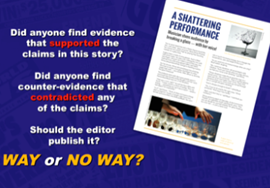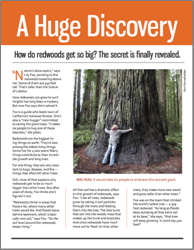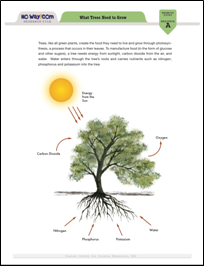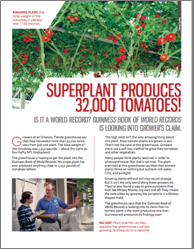In this activity, students become editors at NoWay!com, a web site that publishes amazing-but-true stories. Two stories being considered for publication include claims about photosynthesis. Students must evaluate the validity of the claims by looking for relevant evidence in the informational resources provided. Based on what they find, they decide whether or not the site should publish the stories.
![]() This classroom activity, a central feature of our modules, offers a fun way for students to develop the critical thinking and science literacy skills emphasized in the Next Generation Science Standards—skills they’ll need in order to become critical consumers of scientific information and reporting. Moving away from the fantasy worlds of the video games, No Way! draws students into a compelling real-life scenario in which they are editorial interns at a science-themed website—NoWay!com.
This classroom activity, a central feature of our modules, offers a fun way for students to develop the critical thinking and science literacy skills emphasized in the Next Generation Science Standards—skills they’ll need in order to become critical consumers of scientific information and reporting. Moving away from the fantasy worlds of the video games, No Way! draws students into a compelling real-life scenario in which they are editorial interns at a science-themed website—NoWay!com.
 |
| After evaluating the claims in a story, students decide whether the site should publish it. |
The site publishes amazing-but-true stories about incredible natural phenomena, weird inventions, and sensational events. As part of the editorial team, students must investigate claims in articles being considered for publication on the site. The articles connect to the module’s content and focus on the misconception addressed in the video game. Playing No Way! gives students a chance to practice crucial argumentation skills while also deepening their understanding of the module’s topic.
The articles students evaluate were written specifically for No Way! Each contains several claims that have to be checked. The rule is that finding counterevidence for any claim means the story can’t be posted. The activity involves (a) looking for information relevant to a claim by referring to a set of reliable resources we provide, and (b) determining whether the information they find constitutes evidence for or against the claim. While students will find evidence to corroborate most claims, the game keeps them focused on the search for counterevidence that invalidates a claim.
It takes 2–3 classes to complete the activity. Sessions end with students sharing what they’ve discovered and voting on whether a particular story should be published.
 |
| Students investigate claims made in this story about redwood trees. |
In this activity, students are tasked with investigating two articles that contain claims about photosynthesis. The related video game, The Ruby Realm, addresses the misconception that soil provides the mass in plants, and helps students construct an understanding of photosynthesis by letting them actively participate in the process of chemical change. This activity provides an opportunity for students to use their understanding of photosynthesis to help them evaluate claims in two stories about amazing plants being considered for publication on NoWay!com.
After viewing the introductory slideshow, students turn their attention to the first story, “A Huge Discovery.” It’s about a guide who leads tours of California’s redwood forests and who believes she has solved the mystery of how “nature’s skyscrapers” can grow to such towering heights.
 |
| One of the resources students use to investigate claims about redwoods. |
The four claims in the story have to do with the physical features and growth of redwoods. Working in small groups, students look for and record information relevant to the claims by going through a set of data resources provided. Then they decide if the information constitutes evidence for or against each claim. They can find plenty of information in the resources to support the claims about the physical features of redwoods and the conditions in which they thrive. But the tour guide’s claim about how redwoods grow to be so huge is based on the misconception that it’s soil that provides their mass. The resources contain information that serves as convincing counterevidence to this claim.
Since NoWay!com’s policy is to not post stories that contain any false claims, students will be making a wise decision if they reject “A Huge Discovery” for publication based on the counterevidence they find in the resources.
 |
| Students investigate claims made in this story about an amazingly productive tomato plant. |
The second article is about tomato growers who say they harvested 32,000 tomatoes from a single plant! They claim that’s a record yield, and want the plant included in the Guinness Book of World Records. The story also describes the soilless method they used to grow their superplant, saying it thrived on nothing but nutrient-rich water, carbon dioxide, and sunlight. There is plenty of information in the resources to support the four claims in the story, and none that serves as counterevidence that would invalidate any of the claims. If students decide that NoWay!com should use this article, they won’t be in danger of publishing a story that contains a false science claim.
[Note: If this is the students’ first experience with No Way!, they should learn about the activity’s premise and rules by viewing the Day 1 Sideshow. It includes a guide to the claim-checking process they’ll be using as they go through the activity.]
We suggest spending three class periods on this activity. These are the materials you’ll need each day:
No Way! Activity: Photosynthesis DAY 1 Instructions
DAY 1 Slideshow (to show to the class)
“A Huge Discovery” Article (one copy per student)
Redwood Story: Finding Claims Worksheets
(one set per student)
No Way! Activity: Photosynthesis DAY 2 Instructions
DAY 2 Slideshow (to show to the class)
Redwood Story Resources
(one set for each group of four students)
Redwood Story: Checking Claims Worksheets
(two sets for each group of four students)
“Superplant Produces 32,000 Tomatoes!” Article
(one copy per student)
Tomato Story: Finding Claims Worksheets
(one set per student)
No Way! Activity: Photosynthesis DAY 3 Instructions
DAY 3 Slideshow (to show to the class)
Tomato Story Resources
(one set for each group of four students)
Tomato Story: Checking Claims Worksheets
(two sets for each group of four students)
The No Way! critical thinking activity connects to Practice 7: Engaging in Argument from Evidence. It offers students opportunities to evaluate and critique scientifically based arguments in the media, an ability emphasized in the NGSS description of Practice 7: “The scientist and the citizen alike must make evaluative judgments about the validity of science-related media reports and their implications for people’s own lives and society. Becoming a critical consumer of science is fostered by opportunities to use critique and evaluation to judge the merits of any scientifically based argument.”
No Way! directly addresses two specific goals of Practice 7: Engaging in Argument from Evidence: